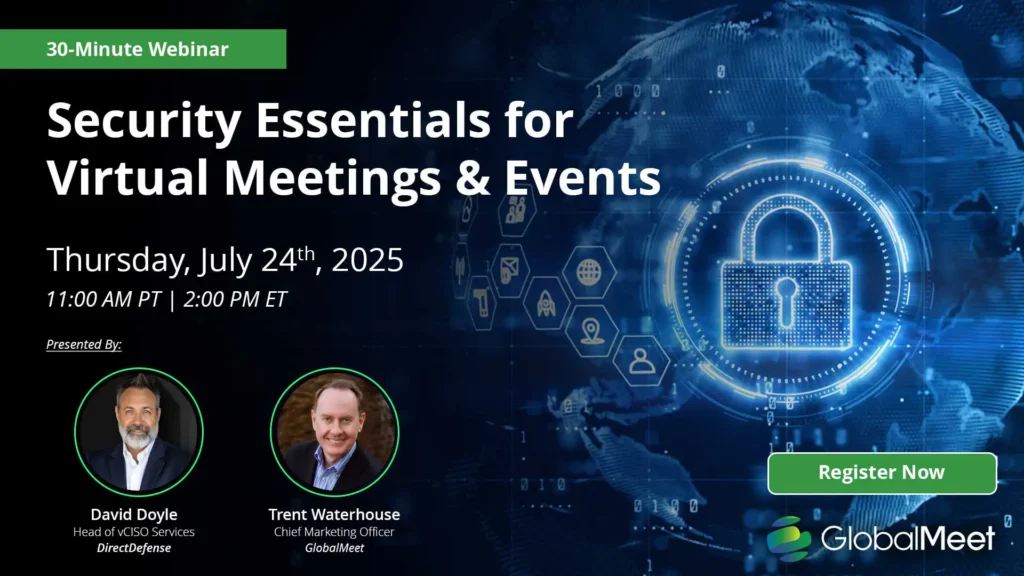
How to Ensure Secure Video Webcasting for Your Business
- by GlobalMeet Blog Team
- ,
With the rise of remote work and virtual collaboration, businesses must prioritize video webcasting security to protect sensitive information from cyber threats. As a result, video webcasting has become an essential tool for corporate communications, training, product launches, and even investor relations. As organizations increasingly rely on virtual events to connect with employees, clients, and stakeholders, the demand for secure video webcasting has never been higher. With the average cost of a data breach reaching millions of dollars, safeguarding your virtual meetings and broadcasts is not just a technical necessity — it’s a business imperative.
Why Security in Webcasting Matters
The ever-increasing popularity of video webcasting and virtual events also brings an increase in security risks and regulatory scrutiny. Cybercriminals have become more sophisticated, targeting online meetings and live streams with tactics like DDoS attacks, unauthorized access, phishing, and data interception. Sensitive information such as financial reports, intellectual property, client data, and internal policies can all be exposed if security measures are not in place, leading to critical compliance failures.
Common Threats in Video Webcasting
- Unauthorized Access: Hackers or unwanted attendees joining your webcast without permission could lead to data leaks or disruption and “zoom bombing”.
- Data Interception: Unencrypted streams can be intercepted, exposing sensitive content to malicious actors and putting organizations at risk.
- Credential Theft: Insecure login methods can lead to stolen passwords and unauthorized entry. Especially with the rise of Bring Your Own Device (BYOD) policies.
- Phishing Attacks: Participants may receive fraudulent links posing as webcast invitations, and have their systems compromised as a result.
These threats can compromise company data, damage your reputation, and even result in legal consequences, especially if compliance standards aren’t met.
Key Security Features to Look For
To ensure secure online video webcasting, it’s important to use a platform that offers enterprise-grade security controls. Here are essential features to prioritize:
End to End Encryption
Encryption ensures that data transmitted between participants and servers is unreadable to anyone who might intercept it. E2EE adds an extra layer by encrypting data on the sender’s device and only decrypting it on the receiver’s device.
Multi Factor Authentication
MFA adds a layer of security by requiring users to verify their identity using two or more authentication methods, such as a password and a phone verification code. This is especially valuable in BYOD environments where devices will have been secured via multiple methods.
Single Sign On
Single Sign On (SSO) integrations and Security Assertion Markup Language (SAML) communications can also help secure internal systems by utilizing dynamic access controls. Central authentication provides additional security where it’s needed most, reducing the risk of password breach, and improving user experience.
Access Controls and Permissions
Implementing source domain restrictions and user-level permissions ensures that only authorized individuals from specified domains or IP addresses can access your webcast.
Password Protected Events
Secure webcasting platforms allow hosts to protect meetings with passwords or PIN codes to restrict entry to invited participants only, reducing the risk of disruptive or malicious attendees.
Recording Restrictions
To protect proprietary information, the best platforms ensure that only authorized users can record or download webcast sessions.
Secure Content Distribution
Content Delivery Networks (CDNs) should support HTTPS and token-based access to prevent unauthorized sharing of webcast URLs.
Compliance Considerations for Secure Video Meetings
Organizations in healthcare, finance, legal, and other regulated industries must ensure their video webcasting tools meet compliance standards. Failure to do so can result in significant fines and reputational damage.
Key Compliance Standards
GDPR (General Data Protection Regulation): Applies to any organization handling the data of EU citizens. It gives individuals control over how their data is collected, used, and shared. It also requires data minimization, consent management, and transparency.
CCPA (California Consumer Privacy Act): Grants California residents rights to know, delete, and opt out of the sale of their personal data. It requires businesses to tell consumers what data is being collected, and why, and gives them the right to request deletion at any time.
SOC 2 (Service Organization Control 2): Focuses on how service providers securely manage data to protect the privacy and interests of their clients by assessing privacy, security, availability, and confidentiality. Companies that pass a SOC 2 Audit likely have strong systems and controls in place to keep information secure.
Using a platform that offers built-in compliance tools — such as secure data centers, encrypted storage, audit logs, and customizable access controls — is essential for meeting these requirements and ensuring that your webcasts are secure.
Best Practices for Best Practices for Secure Webcasting
Even with the right platform, businesses must adopt proper practices to ensure secure video webcasting.
Password Protection
Set up passwords for all webcasts and never share them publicly. Only distribute them through secure channels ensuring all data is encrypted in transit and at rest.
Leverage a Secure Network
Avoid public Wi-Fi for hosting or attending webcasts. Encourage staff to use VPNs and secure internet connections.
Train Employees on Security Protocols
Employees should understand the basics of cyber hygiene — such as recognizing phishing emails, using strong passwords, and not sharing login details.
Monitor Attendance and Access
Use platform features to monitor who joins your webcast. Remove unauthorized attendees immediately and disable re-entry for removed users.
Control the Audience Experience
Ensure participants can’t disrupt the webcast with loud noises or disruptive chats, restrict screen and content sharing to hosts. Lock the meeting once it has started to prevent new participants from joining.
Keep Software and Platforms Updated
Use the latest version of your webcasting platform to ensure you have the most up-to-date security patches and features.
Why Chose GlobalMeet for your Secure Video Webcasting
For businesses that need a trusted, secure solution for webcasting, GlobalMeet stands out with its robust, enterprise-grade security features. GlobalMeet is also unique with dedicated in-house information security personnel and Data Privacy Officer.
- Private Cloud: GlobalMeet owns and operates our own private streaming-as-a-service infrastructure to reduce cyberattack targeting risks.
- End-to-End Encryption: Ensures that content and attendee data is encrypted at every stage of delivery.
- Multi-Factor Authentication: Available for all users, reducing the risk of unauthorized access and unauthorized attendees or presenters.
- Custom Access Controls: Restrict access by IP, email domain, or invitation-only settings while limiting or preventing multiple logins using the same email address.
- Compliance Certifications: Supports GDPR, CCPA, and SOC 2 requirements.
- Secure Data Centers: Hosted in geographically diverse, ISO 27001-certified facilities.
- Controlled Content Distribution: Tokenized URLs and viewer-specific access help prevent content leaks.
- Audit Logs and Reporting: Get detailed insights into who accessed what, and when.
Additionally, GlobalMeet offers seamless integrations with enterprise communication systems, single sign-on (SSO), and dedicated customer success teams to help you manage secure events from planning to execution.
Conclusion
As remote collaboration and digital communication continue to grow, ensuring secure video webcasting is critical to protecting your business and maintaining trust with stakeholders. The risks of unprotected content — from data breaches to compliance violations — are too significant to ignore.
By choosing a platform like GlobalMeet and following best practices such as encryption, access control, and employee training, businesses can confidently host secure, compliant webcasts that protect their most valuable asset: information.
Secure your next webcast with confidence — because in today’s digital world, security is not optional, it’s essential.

Elevating Safety and Connection: Hybrid Events for Senior Leadership
- by GlobalMeet Blog Team
- ,
In an era where senior executives are navigating increasing time constraints and evolving risks, hybrid events are emerging as a strategic solution that marries safety with meaningful stakeholder engagement. These events, which combine in person and virtual participation, offer executives the flexibility to connect without compromising security or effectiveness. By exploring the potential of hybrid formats, businesses can ensure a balanced approach to corporate safety strategy and impactful communication.
Hybrid events aren’t just a response to current challenges — they represent an evolved approach to leadership visibility, stakeholder communication, and event execution. As organizations prioritize safety without wanting to dilute the value of personal connections, hybrid models present themselves as adaptable and efficient mechanisms for maintaining relevance and operational resilience.
Balancing Safety and Connection
Senior leadership plays a pivotal role in maintaining strong relationships with stakeholders, serving as the face and driving force behind an organization’s strategic direction. However, public appearances often come with heightened safety considerations and logistical challenges. These concerns can limit the ability of executives to engage widely and effectively. Hybrid events bridge this gap by enabling executives to balance accessibility with security, providing a platform to engage stakeholders both locally and globally in a manner that is both impactful and secure. By combining the best of in-person and virtual formats, hybrid events empower executives to expand their reach, amplify their message, and address the dynamic needs of their audience without taking on unnecessary risks.
Leverage both in-person and virtual formats
This dual approach allows leaders to maintain personal connections while reducing physical risks. Whether it’s addressing a local audience or reaching international stakeholders, hybrid events offer scalable options for every scenario.
Enhance stakeholder relationships
With seamless integration of virtual and physical elements, executives can connect with audiences across the globe without sacrificing quality or engagement. Virtual elements facilitate on-demand content delivery, ensuring greater inclusivity for diverse time zones.
Mitigate risks in public settings
By offering an alternative to in person attendance, hybrid events reduce the likelihood of exposing leadership to physical threats or health risks. Risk management strategies can be seamlessly integrated into the design and execution of such events, offering flexibility without compromising efficacy.
Advantages of Hybrid and Virtual Events
Hybrid and Virtual Events provide a unique opportunity to elevate corporate risk management strategies whilst amplifying engagement. By enabling real time adaptation to challenges and integrating innovative tools, these formats demonstrate unparalleled versatility and advanced capabilities. From fostering high quality connections to addressing complex security and logistical needs, hybrid events serve as a cornerstone for modern leadership strategies, and continue to redefine engagement.
Remote Participation without Compromising Visibility
Senior executives can join events from any location, ensuring their presence and input are felt without the need for travel or physical attendance. This enhances flexibility and allows for increased participation, even when schedules are tight.
Cutting Edge Technology
Tools such as live streaming, interactive Q&A sessions, and virtual networking platforms enable meaningful interactions that mirror in person experiences. Attendees can engage with senior leadership seamlessly, fostering trust and report. High quality video, live captioning, and translation tools further enrich accessibility and the event experience.
Global Reach and Accessible Access
Hybrid formats remove geographical barriers, enabling broader participation and enhanced inclusivity whilst reducing time and resource constraints. This means audiences and stakeholders can attend without logistical challenges, promoting accessibility and engagement at scale.
Customizable security solutions
The adaptable nature of hybrid events lends itself to advanced security measures, ensuring the protection of both executives and vital communications.
Flexibility to Respond in Real Time
Hybrid formats allow adjustments based on situational needs, such as changing public health policies or unforeseen security challenges. Organizers can adapt attendance protocols, venue logistics, or online setups dynamically to address any emerging concerns.
Enhanced Cybersecurity
By leveraging robust virtual event platforms, businesses can protect sensitive communications from threats like cyber-attacks or unauthorized access. Advanced encryption and multifactor authentication ensure secure connections, while backup systems guarantee continuity of communications even in the face of disruptions.
Scalability and Resilience
From small team meetings to global summits, hybrid platforms can accommodate varying scales while upholding the highest security standards. Tailored solutions allow events to scale efficiently while remaining prepared for potential threats, both virtual and physical
Planning for the Future of Corporate Events
Hybrid and virtual event formats represent more than a short-term solution. They are shaping the future of corporate gatherings. By integrating safety, flexibility and connectivity, business can make sure that they stay relevant and up to date.
Invest in long term solutions
Adopting hybrid events as a standard practice supports ongoing risk mitigation whilst fostering deeper connections with stakeholders Building permanent infrastructure around hybrid models ensures readiness for any eventuality.
Streamline Risk Management through Technology
Advanced event technology enables real-time monitoring and response, ensuring a proactive approach to event safety. Predictive analysis can assess risks and inform decision-making before and during events.
Futureproof Corporate Engagement
As global challenges evolve, hybrid and virtual platforms provide a resilient framework for ongoing communication and collaboration. Embracing these models will position organizations as forward thinking and adaptive to change, securing their leadership role in complex and uncertain environments.
Long term planning can also facilitate integration with emerging trends such as AI driven participant engagement, or carbon offsetting in event planning, promoting not only safety but sustainability and technological sophistication.
Conclusion
Hybrid events offer an innovative pathway for senior leadership to manage the delicate balance between safety and connection. By harnessing the power of virtual and in person integration, executives can effectively navigate today’s challenges while building meaningful relationships. These formats present an opportunity for organizations to rise to the occasion by demonstrating agility, foresight, and a commitment to excellence.
Embracing this dynamic approach ensures that safety and engagement remains central to corporate strategies, paving the way for a connected and secure future. Hybrid events — where safety meets innovation — are defining the future of leadership communication, ensuring organizations remain adaptable and impactful in an ever-changing landscape.

Reducing Event Overhead with Enterprise Event Management Software
- by GlobalMeet Blog Team
- ,
The rapidly evolving corporate event landscape is driven by rising costs, technological advancements, and the need ever present for sustainability. Geopolitical uncertainties, fluctuating tariffs, and escalating material expenses — such as booth setups, giveaways, and paper goods — are pushing organizations to rethink their event strategies. Traditional in-person events are not only expensive but also increasingly impractical for large-scale operations.
In response, hybrid events, supported by enterprise event management software and enterprise video streaming solutions, are emerging as the future of corporate gatherings. These technologies are transforming how organizations manage events, enabling them to reduce costs, increase engagement, and future-proof their operations.
The Technological Shift in Event Management
The reliance on technology for event management is no longer optional. Businesses increasingly turn to enterprise event management software to streamline event planning, execution, and post-event analysis. These platforms centralize logistics, enabling teams to manage registrations, track attendee engagement, and oversee budgets with ease.
For example, integrating enterprise video streaming solutions allows event organizers to create immersive, interactive virtual experiences. These solutions complement in-person events, ensuring that time is well spent for both those present in the room and remote attendees. A dual approach maximizes the reach and impact of events, whilst significantly reducing overhead costs.
Hybrid Events: A Cost-Effective and Flexible Alternative
Transitioning to hybrid events has become a pivotal strategy for organizations looking to reduce expenses without sacrificing engagement. Here’s why:
Lower Operational Costs
In-person events come with a host of expenses, from venue rentals and catering, to travel and accommodation for attendees. By adopting a hybrid model, businesses can scale back on physical logistics and allocate resources more efficiently. Enterprise conferencing solutions make it possible to connect virtual attendees seamlessly, eliminating the need for additional venues or travel expenses.
Expanding Audience Reach
A hybrid model ensures that events are accessible to a broader audience. Our recommendation to customers is simple: if an in-person event expects 100 or more attendees, going hybrid is essential. Enterprise video streaming solutions allow remote participants to join from anywhere, increasing overall attendance and return on investment. With assistive technologies integrated into enterprise streaming solutions, events are more inclusive, catering to individuals with diverse needs. Additionally, recorded sessions can be repurposed as on-demand content, extending the life and value of the event long after it concludes.
Flexibility for Attendees
Hybrid events cater to the modern attendee’s needs. Participants can decide to join last-minute without incurring significant travel costs, eliminating the average $1,800 typically required to attend a large-scale event in person. This flexibility ensures greater inclusivity and higher attendance rates, meaning you get more value for your money.
Mitigating Uncertainty
Hybrid events are inherently adaptable. Whether geopolitical factors lead to travel restrictions, or economic downturns limit budgets, a hybrid approach ensures that events can proceed with minimal disruption even in a rapidly changing world. Enterprise event management software provides the scalability needed to adjust event formats quickly, keeping operations running smoothly under any circumstances.
Maximizing ROI and Engagement
Investing in enterprise event management software doesn’t just reduce costs; it also enhances the return on investment (ROI) by driving greater participant engagement which results in more leads, more customers, and more revenue.
Data-Driven Insights
These platforms offer robust analytics capabilities, allowing event organizers to track attendee behavior, and measure the success of sessions. This data helps refine future events, ensuring they align more closely with audience preferences and business objectives.
Enhanced Interactivity
Enterprise video streaming solutions now include features such as live polls, Q&A sessions, and breakout rooms, enabling remote attendees to participate as actively as those on-site. This level of interactivity fosters a sense of inclusion, driving higher engagement and satisfaction among all participants.
Cost-Effective Networking
One of the challenges of virtual events has traditionally been replicating the networking opportunities of in-person gatherings. However, modern enterprise conferencing solutions now incorporate AI-driven matchmaking, virtual lounges, and other tools to facilitate meaningful connections, ensuring that attendees derive maximum value from the event. The financial advantages are also compelling, with significant savings to be made by reducing on site attendance costs for meals, rooms, and entertainment. By shifting to a hybrid model, organizations significantly lower overheads while maintaining high-quality experiences for all attendees.
Future-Proofing Corporate Events
As the pace of technological innovation accelerates, organizations must adopt scalable solutions to remain competitive. Enterprise event management software and hybrid models are crucial components of a future-proof event strategy.
Scalability for Any Event Size
Unlike traditional events constrained by physical space, hybrid events can scale effortlessly. Whether the audience is 100 or 100,000, enterprise platforms handle large volumes of participants without compromising quality, ensuring businesses can grow their event strategies alongside their objectives, no matter what challenges arise.
Sustainability and Environmental Impact
Hybrid events are not only cost-efficient but also environmentally responsible. By limiting the need for travel and physical materials, each attendee saves approximately 2 metric tons of CO2 emissions. This aligns events with broader corporate sustainability goals, offering an eco-friendly alternative to traditional formats.
Integration of Emerging Technologies
The integration of technologies such as AI, AR/VR, and advanced analytics into enterprise event management software is revolutionizing the attendee experience. Virtual reality booths, for example, can replace traditional physical exhibits, offering an engaging yet cost-effective alternative.
Practical Advice for Event Planners
For businesses navigating this new landscape, the following steps can help maximize the benefits of enterprise conferencing solutions and hybrid events:
- Evaluate Event Goals: Understand the purpose of the event and determine the ideal balance between in-person and virtual components.
- Leverage Data Effectively: Use analytics from enterprise event management software to inform decisions, tailor future events, and demonstrate clear ROI.
- Invest in Training: Ensure teams are well-versed in the capabilities of enterprise conferencing solutions to fully utilize their features.
- Plan for Scalability: Choose platforms that can grow with your organization, accommodating larger or more complex events over time.
Focus on Engagement: Incorporate interactive elements to keep both in-person and virtual attendees involved throughout the event.
Conclusion:
Enterprise event management software and hybrid event strategies are revolutionizing the corporate events industry. By reducing costs, enhancing engagement, and offering unparalleled scalability, these technologies are enabling businesses to navigate uncertainties and future-proof their operations whilst addressing the challenges of an unpredictable global environment.
In an era where adaptability is key, embracing these solutions isn’t just an option — it’s a necessity. Companies that invest in hybrid event strategies today will be better equipped to thrive in the dynamic digital landscape of tomorrow.

Maximizing the Benefits of Virtual Events in the Tech Industry
- by GlobalMeet Blog Team
- ,
In today’s tech-driven world, whether you are at the helm of a cutting-edge SaaS firm, delivering top-notch IT solutions to global enterprises, or pushing the boundaries of innovation in any sector, webcasting technology can revolutionize how your organization is attacking lead generation, brand enhancement, and internal communication.
Stirring Up Enthusiasm for Your Products
Webcasts serve as dynamic tools to generate excitement and foster trust among end-users, regardless of their position in the sales journey. Equipped with comprehensive analytics, you no longer need to rely on guesswork to assess your webcast’s impact. Benefits of virtual events, such as engaging features like audience chat, polling, and Q+A sessions keep your viewers hooked, offering valuable insights into which aspects of your content resonate most with your audience.
Most importantly, webcasts allow you to deliver product-focused information and education in an engaging manner. Tailor your content to suit your audience’s preferences, so your sales team can seal the deals.
Crafting a Distinct Brand Identity
Your brand is your digital calling card, and personalizing webcasts by incorporating your brand’s colors, logos, and other elements can elevate your company’s presence.
Harnessing Your Customers as Brand Advocates
Chances are, you have a base of satisfied clients who are already fans of your services. Let them take the spotlight by featuring guest presenters, pre-recorded videos, and testimonials that highlight the most valuable aspects of your products and services. With GlobalMeet, you can seamlessly weave these elements together for a polished and professional presentation, all while ensuring crystal-clear audio and video quality.
Establishing Thought Leadership in Your Field
Webcasts serve a multitude of purposes, from lead generation to educating end-users about product features, service offerings or introducing new innovations. Thought leadership is no longer just a marketing buzzword; it’s a vital strategy for tech companies looking to gain trust and stay top-of-mind with clients and prospects. Lead the conversation in a compelling, dynamic manner and give your audience the option to revisit it with on-demand viewing.
Safeguarding Proprietary Knowledge and Insights
Whether you’re hosting a product launch or an investor relations earnings call, certain information should remain confidential, shielded from competitors and sometimes the public eye. Enterprise-level security measures, including gated access, password protection, and login authentication, ensure your event is safe and secure.
Generating Revenue
While putting your brand in the spotlight is crucial, it’s important to maximize your events to net a positive ROI. GlobalMeet offers seamless API integration with your CRM and other tools, empowering your sales team to follow up with leads post-event, address their specific pain points, and close deals that align with your sales targets.
Room to Expand
GlobalMeet is not just a one-size-fits-all solution; it offers the flexibility to sell, promote, and build brand trust through one-to-many interactions efficiently and cost-effectively. Utilizing the benefits of virtual events, you can easily scale up to reach global audiences numbering in the thousands, all while presenting your company and events in a manner that mirrors the excellence of the services and products you provide.
Connect with us today to schedule a demo and discover how GlobalMeet can empower your tech endeavors.
Ensuring Security in Today’s Virtual World
- by GlobalMeet Blog Team
- ,
In today’s digital world, it’s crucial to understand the importance of privacy and security when hosting a virtual event. While the terms privacy and security may seem interchangeable, there are slight differences between the two concepts. Choosing the right webcasting technology for your needs can help ensure both privacy and security of your event.
At GlobalMeet, we understand the importance of enterprise-grade security for virtual events. Continue reading below to learn more about how our enterprise-grade security measures can help protect your event.
Understanding the Key Differences Between Online Security and Privacy
Privacy ensures that no one outside your organization can listen in on your virtual event. After all, you don’t want intruders accessing trade secrets or confidential information discussed during your event. On the other hand, security ensures that hackers and other cybercriminals cannot use your virtual event connection to access your entire network.
For certain events, such as internal product launches and financial reviews, stakeholders may need to know that your event and its contents are kept private. In many instances, it’s even required by law to ensure certain information remains confidential.
Similarly, if you’re holding a C-level quarterly update, you want your discussions kept private. The same applies to town halls where you may share proprietary or confidential company information.
Why Strong Security Measures are Crucial for Building Trust with Customers
According to the latest Cost of a Data Breach Report published by IBM and the Ponemon Institute, data breaches cost companies an average of $4.24 million per incident. Additionally, data breaches can cost a company the trust of its employees, customers, clients, and partners. As a result, protecting personal information requires adequate security, as it has since the inception of the internet.
Discover How GlobalMeet Webcast Can Help with Your Security and Privacy
GlobalMeet Webcast is proud to offer a wide range of features to ensure the privacy and security of your event. These features include multi-factor authentication, encryption technologies and security controls.
Whether you are planning to host a virtual or hybrid event, it’s crucial to ensure the privacy and security of all attendees. Schedule a demo today to learn more about GlobalMeet Webcast and how our enterprise-grade security can assist you.





